|
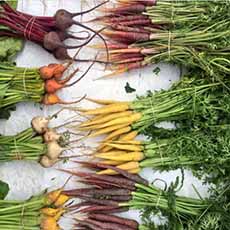
[1] Different colors of beets and carrots (photo © The Chef’s Garden).
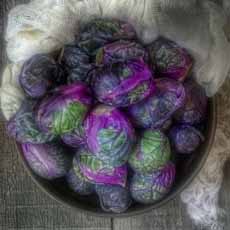
[2] Purple brussels sprouts (photo © Frieda’s Specialty Produce).
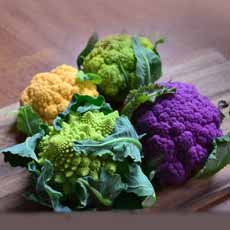
[3] Cauliflower in the conventional white, plus orange and purple. In the front is romanesco, a variation of cauliflower that has spikes (photo © Nourish The Roots).
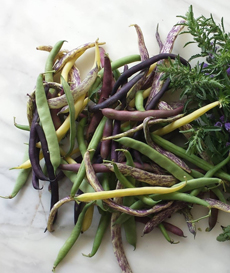
[4] Green beans don’t have to be green photo © The Pines Restaurant | Brooklyn).

[5] Red butterhead lettuce is just one of several red leaf lettuces (photo © Good Eggs).
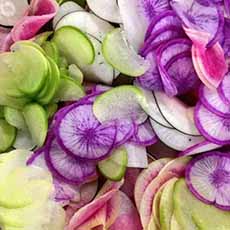
[6] Colored radishes (photo © The Chef’s Garden)
|
|
September is National Fruits & Vegetables Month. You know that fruits come in a rainbow of colors, but how about veggies?
Sure, you can find multicolored baby carrots, bell peppers, chiles and heirloom tomatoes.
But there’s much more to look for.
So today’s tip is: Keep an eye out and treat yourself to whatever is new and different.
Grocers know that customers want new options, so even if there’s no farmers market near you, keep looking.
It’s not just about fun; there are nutritional benefits as well. Colored foods tend to be more antioxidant rich than pale and white foods.
For example, orange cauliflower contains high levels of beta-carotene; purple cauliflower contains anthocyanin, an antioxidant that gives purple color to a variety of foods, including red cabbage and red onions. Green cauliflower just happens to have more protein than the other colors.
Some of the veggies below are natural mutations (as was red grapefruit and many other foods); some are cross-bred. None are GMO.
Asparagus: Look for purple and white in addition to green.
Beets: Beyond red beets, look for orange, yellow and white (photo #1). Chioggia beets have red skin, but a surprise interior of concentric red and white circles.
Bell Peppers: Beyond the familiar green and red are black (purplish), orange, yellow and white bell peppers (photo). They all start out green, and ripen into the different colors.
Brussels Sprouts: Look for the pretty purple variety (photo #2).
Cabbage: You may use green and red/purple cabbages, but have you tried the beautiful Savoy cabbage with its crinkled leaves? It’s green, as are bok choy and Chinese cabbage, but don’t don’t overlook them when you’re looking for variety.
Cauliflower: White cauliflower is now joined by orange, purple and pale green (photo #3).
Chiles: A nice accent for those who like heat, different varieties are available beyond the familiar red and green, to brown, orange, purple and yellow.
Carrots: The original carrot was white, like a turnip. The other colors—orange, purple, red, yellow—were mutants (photo #1). Here’s the story.
Cauliflower: The familiar white cauliflower is joined by heads of green, orange and purple, all natural mutants of white cauliflower (which itself was bred to be whiter). Green cauliflower, also called broccoflower, has a lighter green cousin.
Endive: Pale green endive has a variety with purplish-red-tipped leaves. It’s the color of radicchio, which is a cousin of endive.
Eggplant: Beyond the familiar dark purple, also grows green (Thai eggplant), lavender, orange (Ethiopian, scarlet or Turkish eggplant), pink, and striped purple and white (graffiti eggplant) and white eggplant. The lighter colored eggplants tend to be less bitterness than the dark purple.
Green Beans: These are a mutation where the skin of a regular green bean grows violet (photo #4). Alas, they are only purple when raw; cooking engenders the familiar green skin. But they sure are impressive crudités! (Photo and more information.) And don’t forget the yellow wax beans. A mix of green and yellow is interesting, and much more available.
Lettuce: Look for red lettuces, including red butter lettuce (photo #5), red oak leaf lettuce and red romaine.
Kale: Kale leaves are largely green, but look for Red Russian Kale, with some reddish leaf tinge and a purple spine.
Microgreens: These tiny sprouts are often green, but some varieties—beet and daikon, for example—are red. In any color, they’re a delightful accent to foods.
Onions: Red onions and shallots are familiar vegetables, but remember to use them for color accents.
Radishes: Most of us know the red skin with white flesh, but look for black radishes (black or brown skin, white flesh), candy stripe radishes (red skin, red and white striped flesh), Easter radishes (orange, pink, purple or white or white skin, white flesh), green radishes (skin and flesh), purple radishes (purple skin, purple and white center), watermelon radishes (green flesh, green flesh with a rosy center)(photo #6).
Red leaf lettuce: There are quite a few varieties of red lettuce. Two of our favorites for “prettiest” are red fire lettuce (scroll past the green lettuce) and the beautifully spotted freckles lettuce.
Romanesco: Also called Romanesque cauliflower, Romanesco broccoli and Romanesque cabbage, there’s a reason for the different names. Professional plant taxonomists can’t decide precisely where this exotic beauty belongs. A natural vegetable first discovered in Italy, it is one of the most beautiful vegetables imaginable (photo #3, plus a closer look here).
Sweet Potatoes: The skin of sweet potatoes can be brown, purple, red, white, or yellow; and the flesh can be orange, purple, white or yellow.
Sweet Red Corn: Look for it during the summer corn season. (Photo.)
Swiss Chard: Long familiar in green with red accents, check farmers markets to find it in vivid orange, pink, purple, yellow and white. (Photo.)
Tomatoes: Anyone who has visited a farmers market has seen the lush colors beyond red: brown, green, orange, purple, striped, yellow, white. While they’re summer produce, you can find mixed color cherry tomatoes year-round.
Isn’t nature grand?
|





